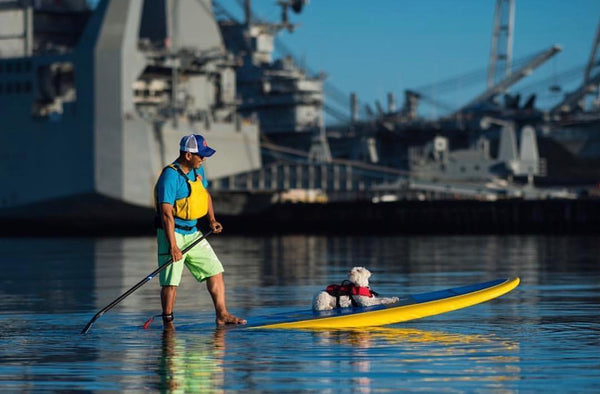
Navigating Legal Safety Requirements for Stand-Up Paddleboarding (SUP)
Legal Safety Requirements for Paddle Boarding: What You Need to Know
Paddle boarding, while serene and exhilarating, comes with its set of legal safety requirements designed to protect you on the water. These regulations, often enforced by local maritime or coast guard authorities, ensure that every paddle boarder is equipped to handle potential emergencies. This post will focus exclusively on the legal necessities for paddle boarding, distinguishing them from the broader scope of safety tips and best practices. Understanding and adhering to these laws not only ensures your safety but also keeps you compliant with regulations, helping avoid fines or penalties.
Key Highlights
-
USCG Classification and Rules:
- In 2010, the U.S. Coast Guard (USCG) classified stand-up paddleboards as vessels, which means paddleboarders must adhere to federal Navigation Rules and carry specific equipment outside designated swimming areas.
-
Personal Flotation Device (PFD) Requirements:
- Children under 13 must wear a USCG-approved PFD at all times.
- Paddlers aged 13 and older are required to have a PFD on board but are not mandated to wear it unless specified by local laws.
-
Types of PFDs:
- Type I PFDs: Designed for all waters, especially open, rough, or remote areas.
- Type II PFDs: Best suited for calm, inland waters.
- Type III PFDs: Ideal for calm waters with a high chance of quick rescue.
- Type V PFDs: For specific activities; must be worn to be effective.
-
Additional Safety Gear:
- All paddleboarders must carry a whistle or other sound-producing device to signal for help.
- If paddling after sunset, a lighting device such as a headlamp or flashlight is mandatory, along with visual distress signals for nighttime.
-
Compliance and Penalties:
- Failing to comply with these safety regulations can result in fines or penalties, emphasizing the importance of understanding and adhering to legal requirements.
The surge in popularity of Stand-Up Paddleboarding (SUP) over the past decade has not only transformed it into a beloved water sport but also prompted a significant shift in how it is regulated. In 2010, a pivotal change occurred when the United States Coast Guard (USCG) officially recognized SUPs as vessels, aligning them with federal Navigation Rules and carriage requirements outside designated swimming, surfing, or bathing areas. This classification carries specific legal safety requirements for paddleboarders, distinct from common-sense safety advice. Here, we focus solely on these legal mandates to ensure paddleboarders are both safe and compliant.
Understanding PFD Requirements
For paddlers under 13, wearing a USCG-approved Type I, II, III, or certain Type V life jackets is mandatory. Paddlers over 12 aren't obliged to wear a life jacket but must have one on their board. Notably, SUP surfers operating within the surf line are exempt from this PFD requirement, a relief to those engaging in SUP surfing.
Types of PFDs Explained
- Type I: Best for open, rough, or remote waters, offering the highest buoyancy and the capability to turn unconscious wearers face-up.

All waters, especially open, rough, or remote waters where rescue can be delayed
Large and awkward; difficult to swim in
Adult size: 22 lb. of buoyancy.
Child size: 11 lb. of buoyancy.
Will turn unconscious wearers to face-up position.
Type II: Ideal for calm, inland waters, with moderate buoyancy but not guaranteed to turn unconscious wearers face-up.

Calm, inland waters where there is a good chance of rescue
May not turn some unconscious wearers face-up
Adult size: 15 1/2 lb. of buoyancy.
Child size: 11 lb. of buoyancy.
Infant size: 7 lb. of buoyancy.
Type III: Suited for calm waters with a good chance of quick rescue, requiring wearers to orient themselves face-up.

Calm, inland waters where there is a good chance of rescue
Wearers must put themselves in face-up position
Same buoyancy as Type II.
examples:
Float coat, fishing vest, water sport vest.
Type IV: Not wearable, designed for throwing to someone in distress, suitable in areas with heavy boat traffic.

All waters where help is present
Not designed to be worn; intended for use in waters with heavy boat traffic
Designed to be thrown and grasped until rescued; never worn.
examples:
Cushions, ring buoys, horseshoe buoys
Type V: For specific activities, with some designed for cold conditions or providing hypothermia protection. Inflatable belt PFDs are popular among paddleboarders for their minimal impact on mobility.

Specific activities; check approval condition on label
Some Type Vs are designed for cooler climates and others are approved only when worn
Some Type V devices provide hypothermia protection.
examples:
Deck suits, work vests, boardsailing vests
The most popular kind of Type V PFD’s for SUP is the “inflatable belt type” as it doesn’t encumber your upper body while paddling.
Inflatable belt PFD

Additional Required Gear
Beyond PFDs, paddleboarders must carry a whistle or other sound signaling devices to alert others in case of an emergency. If paddling after sunset, a headlamp, flashlight, or similar lighting device is mandatory, along with a visual distress signal for night-time paddling.
Related Topics
Learning Guide for Paddle Boarders
Things to Know Before Paddle Boarding in Winter


